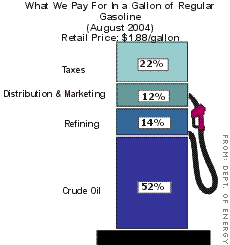NEW YORK (CNN/Money) -
The spot price of a barrel of oil surpassed $50 this week, so car owners should brace themselves for a new round of price hikes at the gas pumps.

According to the Department of Energy, big changes in spot oil prices show up in retail prices, usually 10 days to four weeks later. Between 92 and 114 percent of the spot price change is passed through to retail customers within two-and-one-half months.
Although the price of crude is the major part of gasoline prices, the effect of oil-price changes is dampened by other contributors to the price of gas.
Among those variables: refining costs and profits, distribution and marketing costs and profits, and, especially, taxes. A doubling of crude prices does not result in a doubling of gas prices.
Breaking down the price of gasoline
At the end of 2002, when gasoline averaged about $1.38 a gallon, crude oil hovered around the $30-a-barrel mark and accounted for nearly 46 percent of the price of gasoline, or 63 cents a gallon. The next biggest component, taxes, made up 30 percent, or 42 cents per gallon. Distribution and marketing and refining costs both accounted for about 12 percent, or 17 cents each.
Fast forward to August and September of 2004, when a barrel of oil traded at around $40. Oil prices made up a larger slice of the much bigger gas-price pie, about 52 percent in August, according to the Energy Information Agency (EIA), an arm of the DOE. That means crude prices account for about a dollar of the $1.92 motorists pay for a gallon of gas.
Because petroleum products are used throughout the refining process -- fuel oil is burned to crack the oil, for example, and oils and greases applied to keep equipment operating smoothly -- refining costs also rise when crude does, but at a much lower rate.

In August, refining costs accounted for 14 percent of the price of gas, about 27 cents, a 10-cent rise from December 2002. Jacob Bournazian, a gasoline price analyst at the EIA, says that actual refining expenses do not go up very steeply with the cost of crude. Much of the increase in refining costs probably went to expanded marketing efforts and profits.
Distribution costs are up only slightly as well. You do have to pay more in fuel costs to move gas through a pipeline and in tanker trucks, but it adds only a penny or two to the price of gas.
What doesn't change with shifting crude prices are taxes; they are "static," assessed on a per gallon basis, according to Don Davis, president and CEO of DataStream Market Analysis, which gathers pricing information for oil industry clients. So when other costs rise, taxes account for commensurately less of the burden.
The amount of tax paid on a gallon of gas varies considerably by state, from 26.4 cents in Alaska to a high of 57.6 cents in New York. On a national average, you pay 42 cents per gallon, of which 18.4 cents represents the federal gas tax.
Total impact
All told, the impact of a $10 increase in crude prices "comes to between 30 and 50 cents" on a gallon of gas, says Bournazian. But he adds that when such a crude price increase comes quickly, the impact on gas prices would be "closer to 50 than to 30 cents."
Davis points out that the increase of 20 cents a gallon this year adds less than $5 a month to the bills for all but the most active drivers. Most will spend only an extra dollar or two, a drop in the bucket compared with the other costs of operating a car. (See Costliest places to own a car).
There are a lot of indications that $50-a-barrel crude will continue, according to Bournazian, especially since prices often soften coming out of the summer driving season, when demand is heaviest.
"You don't expect a third-quarter spike in oil prices," he says. "It makes you say, 'my God, what will happen in the fourth?'"
If oil continues to trade in the $50 a barrel range, American consumers will probably expect gas-pump prices near $2.40 a gallon in a few weeks.

|

